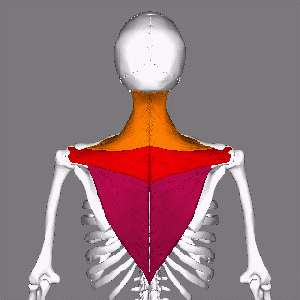Introduction:
The trapezius muscle, commonly referred to as the “traps,” is a prominent and versatile muscle group located in the upper back and neck region. Its distinct triangular shape spans from the base of the skull and upper spine down to the middle of the back and shoulder blades. As one of the largest muscles in the upper body, the trapezius plays a pivotal role in various movements and functions, including shoulder stabilization, neck support, and overall posture maintenance.
The trapezius muscle is divided into three main sections based on its anatomical location: the upper trapezius, middle trapezius, and lower trapezius. Each section contributes uniquely to different movements and actions of the shoulders and scapulae (shoulder blades). Understanding the anatomy and function of the trapezius muscle is essential for developing targeted exercise routines that promote strength, stability, and muscular balance in the upper body.
In this article, we will delve into the intricate anatomy of the trapezius muscle, exploring its three distinct regions and their respective roles in movement and posture. Additionally, we will discuss effective exercises specifically designed to target and strengthen the trapezius muscle, aiding in overall upper body strength, functionality, and aesthetic development. Whether you’re a fitness enthusiast, athlete, or someone looking to improve their posture and shoulder health, understanding the trapezius muscle and incorporating targeted exercises can lead to significant benefits in your fitness journey.

Exploring Trapezius Muscles: Anatomy and Effective Exercises
The trapezius muscles, often referred to as traps, play a crucial role in the stability and movement of the upper back, neck, and shoulders. Understanding the anatomy of the trapezius muscles and incorporating targeted exercises can lead to improved posture, strength, and overall upper body function. In this article, we’ll delve into the anatomy of the trapezius muscles and explore effective exercises to strengthen and tone them.
Anatomy of Trapezius Muscles: The trapezius muscles are broad, triangular muscles that extend from the base of the skull and upper spine down to the middle of the back and shoulder blades. They are divided into three main regions: the upper trapezius, middle trapezius, and lower trapezius.
- Upper Trapezius: Located at the top of the shoulders and neck, the upper trapezius is involved in movements like shoulder elevation (shrugging) and neck extension.
- Middle Trapezius: Situated in the middle of the back between the shoulder blades, the middle trapezius assists in scapular retraction (pulling the shoulder blades together) and shoulder stability during upper body exercises.
- Lower Trapezius: Found in the lower portion of the trapezius muscle, near the lower thoracic spine, the lower trapezius helps with scapular depression (pulling the shoulder blades downward) and shoulder blade rotation.
Effective Exercises for Trapezius Muscles:
- Dumbbell Shrugs: Stand with feet shoulder-width apart, hold dumbbells by your sides, and lift your shoulders upward as high as possible while keeping your arms straight. Lower back down and repeat for several reps to target the upper trapezius.
- Barbell or Cable Face Pulls: Attach a rope or handle to a cable machine or use a barbell with light weights. Pull the rope or bar towards your face, keeping your elbows high and squeezing your shoulder blades together to target the middle trapezius.
- Scapular Retraction Exercises: Lie face down on a bench with arms hanging down and palms facing inward. Squeeze your shoulder blades together to lift your arms off the bench, focusing on activating the middle and lower trapezius.
- Trapezius Dips: Using a dip bar, focus on lowering your body while keeping your shoulders depressed (downward) and engaged, emphasizing the activation of the lower trapezius.
- Overhead Press with Shrugs: Combine a traditional overhead press with shrugging motion at the top of the movement to engage the entire trapezius muscle, particularly the upper fibers.

Conclusion:
Incorporating a variety of exercises that target the different regions of the trapezius muscles can lead to balanced development, improved posture, and enhanced upper body strength. Remember to maintain proper form, gradually increase weight or intensity, and listen to your body’s feedback during trapezius-focused workouts. By including these exercises in your fitness routine, you can achieve a strong and well-defined upper back while promoting overall shoulder health and functionality.
Credits:
Physiopedia
pintrest